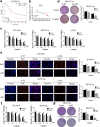Inhibition of AXL enhances chemosensitivity of human ovarian cancer cells to cisplatin via decreasing glycolysis
- PMID: 33149145
- PMCID: PMC8209001
- DOI: 10.1038/s41401-020-00546-8
Inhibition of AXL enhances chemosensitivity of human ovarian cancer cells to cisplatin via decreasing glycolysis
Abstract
Anexelekto (AXL), a member of the TYRO3-AXL-MER (TAM) family of receptor tyrosine kinases (RTK), is overexpressed in varieties of tumor tissues and promotes tumor development by regulating cell proliferation, migration and invasion. In this study, we investigated the role of AXL in regulating glycolysis in human ovarian cancer (OvCa) cells. We showed that the expression of AXL mRNA and protein was significantly higher in OvCa tissue than that in normal ovarian epithelial tissue. In human OvCa cell lines suppression of AXL significantly inhibited cell proliferation, and increased the sensitivity of OvCa cells to cisplatin, which also proved by nude mice tumor formation experiment. KEGG analysis showed that AXL was significantly enriched in the glycolysis pathways of cancer. Changes in AXL expression in OvCa cells affect tumor glycolysis. We demonstrated that the promotion effect of AXL on glycolysis was mediated by phosphorylating the M2 isoform of pyruvate kinase (PKM2) at Y105. AXL expression was significantly higher in cisplatin-resistant OvCa cells A2780/DDP compared with the parental A2780 cells. Inhibition of AXL decreased the level of glycolysis in A2780/DDP cells, and increased the cytotoxicity of cisplatin against A2780/DDP cells, suggesting that AXL-mediated glycolysis was associated with cisplatin resistance in OvCa. In conclusion, this study demonstrates for the first time that AXL is involved in the regulation of the Warburg effect. Our results not only highlight the clinical value of targeting AXL, but also provide theoretical basis for the combination of AXL inhibitor and cisplatin in the treatment of OvCa.
Keywords: AXL; PKM2; R428; Warburg effect; cisplatin resistance; glycolysis; ovarian neoplasms; tumor metabolism.
Conflict of interest statement
The authors declare no competing interests.
Figures






Similar articles
-
R428, a selective small molecule inhibitor of Axl kinase, blocks tumor spread and prolongs survival in models of metastatic breast cancer.Cancer Res. 2010 Feb 15;70(4):1544-54. doi: 10.1158/0008-5472.CAN-09-2997. Epub 2010 Feb 9. Cancer Res. 2010. PMID: 20145120
-
Therapeutic Inhibition of the Receptor Tyrosine Kinase AXL Improves Sensitivity to Platinum and Taxane in Ovarian Cancer.Mol Cancer Ther. 2019 Feb;18(2):389-398. doi: 10.1158/1535-7163.MCT-18-0537. Epub 2018 Nov 26. Mol Cancer Ther. 2019. PMID: 30478151 Free PMC article.
-
The GAS6-AXL signaling network is a mesenchymal (Mes) molecular subtype-specific therapeutic target for ovarian cancer.Sci Signal. 2016 Oct 4;9(448):ra97. doi: 10.1126/scisignal.aaf8175. Sci Signal. 2016. PMID: 27703030
-
Role of the Receptor Tyrosine Kinase Axl and its Targeting in Cancer Cells.Curr Med Chem. 2016;23(15):1496-512. doi: 10.2174/0929867323666160405112954. Curr Med Chem. 2016. PMID: 27048336 Review.
-
Axl inhibitors as novel cancer therapeutic agents.Life Sci. 2018 Apr 1;198:99-111. doi: 10.1016/j.lfs.2018.02.033. Epub 2018 Feb 27. Life Sci. 2018. PMID: 29496493 Review.
Cited by
-
GAS6-AXL Inhibition by AVB-500 Overcomes Resistance to Paclitaxel in Endometrial Cancer by Decreasing Tumor Cell Glycolysis.Mol Cancer Ther. 2022 Aug 2;21(8):1348-1359. doi: 10.1158/1535-7163.MCT-21-0704. Mol Cancer Ther. 2022. PMID: 35588308 Free PMC article.
-
NTNG1 Modulates Cisplatin Resistance in Epithelial Ovarian Cancer Cells via the GAS6/AXL/Akt Pathway.Front Cell Dev Biol. 2021 Jul 1;9:652325. doi: 10.3389/fcell.2021.652325. eCollection 2021. Front Cell Dev Biol. 2021. PMID: 34277602 Free PMC article.
-
Establishment of a novel glycolysis-related prognostic gene signature for ovarian cancer and its relationships with immune infiltration of the tumor microenvironment.J Transl Med. 2021 Sep 8;19(1):382. doi: 10.1186/s12967-021-03057-0. J Transl Med. 2021. PMID: 34496868 Free PMC article.
-
Signaling networks and MiRNA crosstalk in ovarian cancer chemoresistance.J Ovarian Res. 2025 Aug 14;18(1):185. doi: 10.1186/s13048-025-01770-8. J Ovarian Res. 2025. PMID: 40813689 Free PMC article. Review.
-
An Experimentally Induced Mutation in the UBA Domain of p62 Changes the Sensitivity of Cisplatin by Up-Regulating HK2 Localisation on the Mitochondria and Increasing Mitophagy in A2780 Ovarian Cancer Cells.Int J Mol Sci. 2021 Apr 13;22(8):3983. doi: 10.3390/ijms22083983. Int J Mol Sci. 2021. PMID: 33924293 Free PMC article.
References
MeSH terms
Substances
LinkOut - more resources
Full Text Sources
Medical
Research Materials
Miscellaneous

